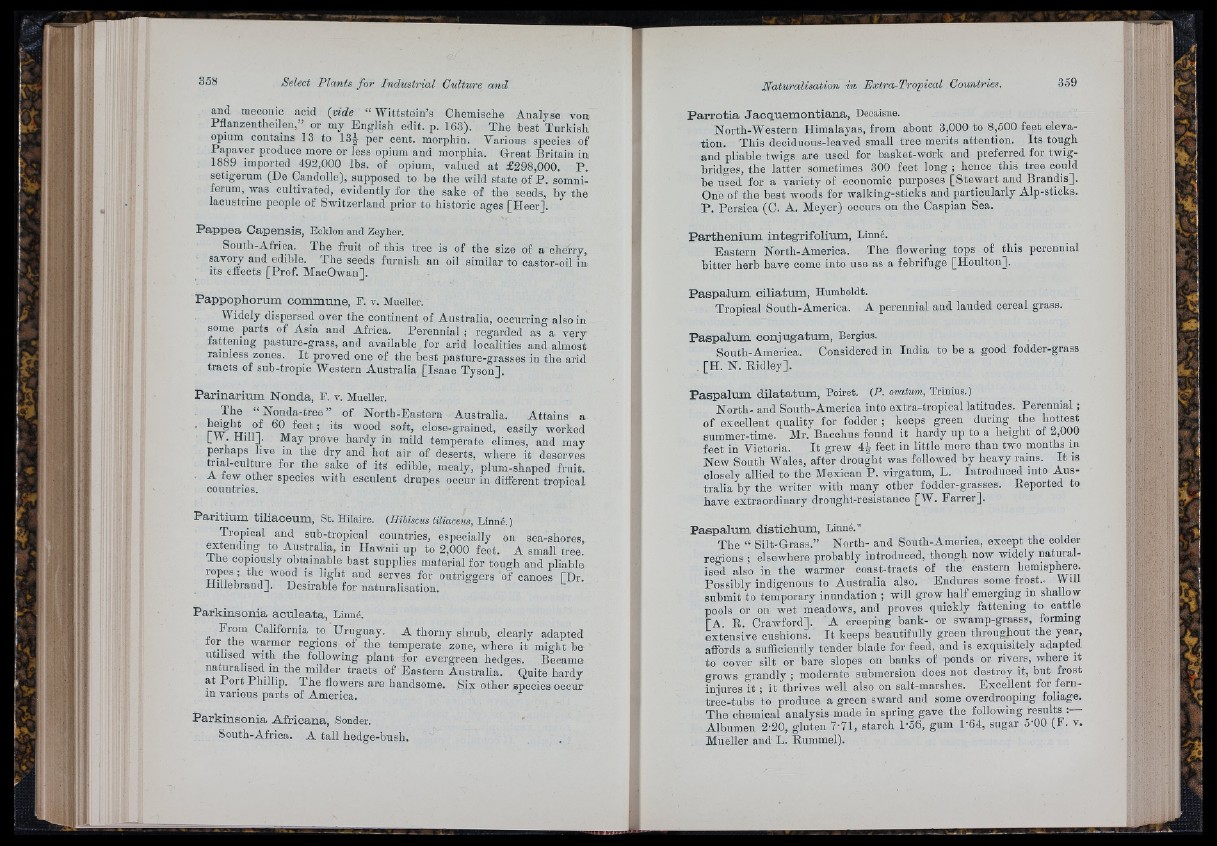
and meconio aoid (vide “ Wittstein’s Chemische Analyse von
Pflanzentheilen,” or my English edit. p. 163). The best Turkish
opium contains 13 to 13J per cent, morphin. Various species of
Papaver produce more or less opium aud morphia. Great Britain in
1889 imported 492,000 lbs. of opium, valued a t £298,000. P .
setigernm (De Candolle), supposed to be the wild state of P . somni-
fernm, was cultivated, evidently for the sake of the seeds, by the
lacustrine people of Switzerland prior to historic ages [Heer].
Pappea Capensis, Ecklon and Zeyher.
South-Africa. The fruit of this tree is of the size of a cherry,
savory and edible. The seeds furnish an oil similar to oastor-oil in
its effects [Prof. MacOwan].
Pappophorum commune, P. v. Mueller.
Widely dispersed over the continent of Australia, oocnrring also in
some parts of Asia aud Africa. Perennial ; regarded as a very
fattening pasture-grass, and available for arid localities and almost
rainless zones. I t proved one of the best pasture-grasses in the arid
tracts of snb-tropic Western Australia [Isaac Tyson].
Parinarium Nonda, P. v. Mueller.
The “ Nonda-tree’[ of North-Eastern Australia. Attains a
' rvi^ u wood soft, close-grained, easily worked
[W Hill]. May prove hardy in mild temperate climes, and may
perhaps live in the dry and hot air of deserts, where it deserves
trial-cultnre for the sake of its edible, mealy, plnm-shaped fruit.
A feAv other species with escnlent drupes occur in different tropical
countries.
Paritium tiliaceum, St. Hilaire. (Hibiscus tiliaccus, Linné.)
Tropical aud sub-tropical countries, especially on sea-shores
extending to Australia, in Hawaii up to 2,000 feet. A small tree.
The copiously obtainable bast supplies material for tough and pliable
ropes ; the wood is light aud serves for outriggers of canoes [Dr.
Hillebrand]. Desirable for naturalisation.
Parkinsonia aculeata, Linné.
From California to Uruguay. A thorny shrub, clearly adapted
lo r the warmer regions of the temperate zone, where it might be
utilised with the following plant for evergreen hedges. Became
naturahred m the milder tracts of Eastern Australia. Quite hardy
at Tort Phillip. The flowers are handsome. Six other species occur
m various parts of America.
Parkinsonia Africana, Sonder.
South-Africa. A tall hedge-bush.
P a r r o t i a J a c q u e m o n t i a n a , Decaisne.
North-Western Himalayas, from about 3,000 to 8,500 feet elevation.
This deciduous-leaved small tree merits attention. Its tough
and pliable twigs are used for basket-work and preferred for twig-
bridges, the latter sometimes 300 feet long ; hence this tree could
be used for a variety of economic purposes [Stewart and Brandis].
One of the best woods for walking-sticks and partioularly Alp-sticks.
P . Persica (C. A. Meyer) occurs on the Caspian Sea.
P a r t h e n i u m in te g r if o lium , Linné.
Eastern North-America. The flowering tops of this perennial
bitter herb have come into use as a febrifuge [Houlton].
P a s p a l u m c ilia tum , Humboldt.
Tropical South-America. A perennial and lauded cereal grass.
P a s p a l u m c o n ju g a tu m , Bergius.
South-America. Considered in India to be a good fodder-grass
[H . N. Ridley].
P a s p a l u m d i l a t a t u m , Poiret. (P. ovatum, Trinius.)
North- and South-America into extra-tropical latitudes. Perennial ;
of excellent quality for fodder ; keeps green during the hottest
summer-time. Mr. Bacchus found it hardy up to a height of 2,000
feet in Victoria. I t grew 4L feet in little more than two months in
New South Wales, after drought was followed by heavy rains. I t is
closely allied to the Mexican P. virgatum, L. Introduced into Australia
by the writer with many other fodder-grasses. Reported to
have extraordinary drought-resistanoe [W. Farrer].
P a s p a lu m d is t ic h u m , Linné.*
The “ Silt-Crass.” North- and Sonth-America, except the colder
regions ; elsewhere probably introduced, though now widely naturalised
also in the warmer coast-tracts of the eastern hemisphere.
IPossibly indigenous to Australia also. Endures some frost.- W ill
submit to temporary inundation ; will grow half emerging in shallow
pools or on wet meadows, and proves quickly fattening to caWle
[A R. Crawford]. A creeping bank- or swamp-grasss, forming
extensive cushions. I t keeps beautifully green throughout the year
affords a sufficiently tender blade for feed, and is exquisitely adapted
to cover silt or bare slopes on banks of ponds or rivers, where it
grows grandly ; moderate submersion does not destroy it, but frost
injures it ; it thrives well also on salt-marshes. Excellent for fern-
tree-tubs to produce a green sward and some overdrooping foliage.
T h e chemical analysis made in spring gave the following results l'Albumen
2-20, gluten 7'71, starch 1-56, gum 1'64, sugar o'OO ( I . v.
Mueller and L. Rummel).
I'M